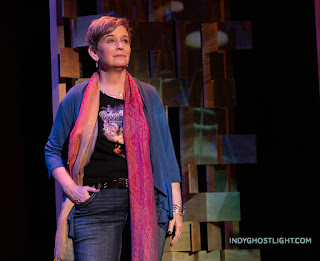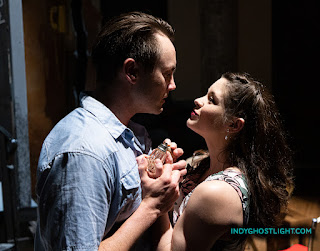Two strong flanks of 'Wild Horses': Constance Macy's impersonation of narrator and her memories
 |
| As narrator of "Wild Horses," Constance Macy reflects. |
People who visit both versions of Phoenix Theatre's new show will have the same delightful task of sorting through their impressions that I did. "Wild Horses," a play by Allison Gregory focusing on a woman's look backward to a life-changing episode of her early adolescence, has two much-admired local actors in alternating performances. The task is to figure out how much your responses to the marvels Jen Johansen and Constance Macy accomplish in the role may depend on whose version you saw first.
Who sheds more light on a particular episode in this fast-moving, close-to-heartbreaking comedy? And whose performance may stand out because first impressions are inevitably stronger than subsequent ones? On the other hand, second impressions that follow soon afterward bear the enviable weight of confirmation or revision of the initial exposure.
To give just one example, on Saturday night I was struck from the start by how Macy brought out the unnamed narrator's self-conscious tone in opening her 80-minute monologue. Those first few minutes carried the burden of how best in middle age to share old, often painful memories with strangers. The style of address is essential to storytelling, and that understandably was not as vivid to me six days earlier in Johansen's first scene, when the need for exposition study dominated my attention to style.
But, I quickly remind myself, last night I had the advantage of knowing the harrowing, uproarious story that was about to unfold. I was likely to see notes struck in how Macy launched her version that might have slipped past me when I was just getting to know the narrator in Johansen's portrayal. Let's agree that when the acting is this accomplished, there's no easy way of avoiding the question of priority. It's a little like trying to figure out the importance of birth order in a family (and that, by the way, is among the issues that play out in "Wild Horses").
Both players have a history of delivering strong accounts of one-actor shows that involve mimicry spread over a wide spectrum of behavior and character. That serves them well here. The detail and precision of Johansen's impersonation of others in the narrator's life remain glorious in recollection. Macy's command of that aspect was also well-drawn, but I have to raise up in particular how well she managed the dynamic of the two sisters (the narrator and "the favorite," as she bitterly refers to Carrie Ann) in a couple of dialogues. The current between them runs strong, though in danger of short-circuiting due to the frayed insulation of the family bond. The electricity in these crucial conversations — one funny, one searing — never dimmed Friday night.
My second viewing of the play gave me more opportunity to admire the show's inspired technical and design aspects. The four elements the ancients recognized figure in the story: Earth, air, fire, and water strut their stuff in sound (Jason Tuttle), projections (Katie Phelan Mayfield), and lighting (Laura E. Glover and Kairon Bullock). The stage environment is a grove of fragmented towers composed of squares resembling wooden shake roofing (Zac Hunter). That material gets a mention in the script when the narrator recalls a wildfire — a phenomenon that we've all learned is a constant in today's California environment. Except for some projected changes of shade and texture, they carry the same cedary color throughout.
Stunningly, at the end of the show, the shake shingles are made gorgeous as if refracted through a prism. Why do we see the wood tones suddenly brightened? It's because the narrator, delivering an assessment of the outcome of the girls' foolhardy adventure, comes close to transfiguration. I've seen this in some previous Macy performances, and there I was again, saying to myself "Uh-oh, here it comes — get ready to feel melted. The ushers may have to reconstitute me at the end. I will be a puddle in Row C."
There are many shows in which the main character changes; in a few of them that's not enough if a performer can't layer a transcendent shift of impersonation on top — "King Lear" is a notable example, which is one reason you so seldom encounter a satisfactory portrayal of the title character.
"Transfiguration" is an odd, dangerous word, often theologically entangled. I can think of several examples in art where it's specifically invoked. The last stanza of "The Battle Hymn of the Republic" opens with these lines: "In the beauty of the lilies Christ was born across the sea, with a glory in His bosom that transfigures you and me."
Here's where Julia Ward Howe casts aside the military ferocity of the preceding verses. John Updike borrowed the first phrase to title one of his novels, in which transfiguration is essential. Passing on to a different plane of existence is implied by the Richard Strauss' tone poem "Death and Transfiguration." Death doesn't have to be the pathway, however, as Arnold Schoenberg made clear in "Transfigured Night," a chamber-music piece with a program in which a man forgives his partner after she announces she's carrying another man's child. Thus their love is transfigured. In homelier fashion, rootsy jazz pianist-singer Mose Allison passed the idea into a stark contrast of country and city life in the concept album that launched his career: "The Transfiguration of Hiram Brown."
What will most stay with me about Constance Macy's version was a feeling I'll never shed that she believably gave the narrator an almost separate persona at the end — linked to teenage experience and a mature woman's recollection of it, but doing more than wrenching retrospective meaning from it. She made it seem as if the narrator had fashioned a whole new person, a separate self, out of her torturously achieved wisdom. It was incredibly moving. There's nothing short of the word "transfiguration" that seems to fit what I saw in Macy's performance. You don't encounter that very often on the stage, and almost never in real life.
[Photo by Indy Ghost Light]



Comments
Post a Comment